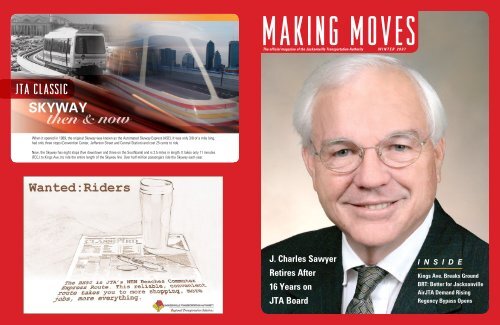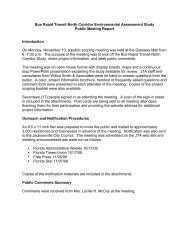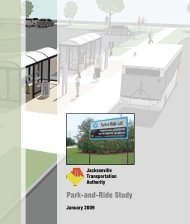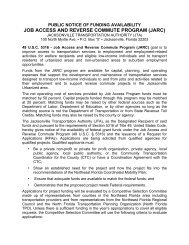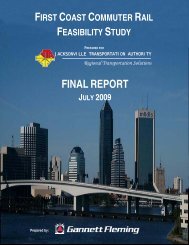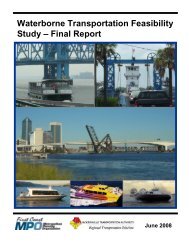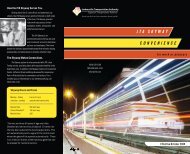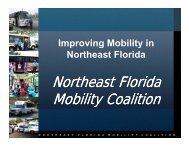jta classic - Jacksonville Transportation Authority
jta classic - Jacksonville Transportation Authority
jta classic - Jacksonville Transportation Authority
You also want an ePaper? Increase the reach of your titles
YUMPU automatically turns print PDFs into web optimized ePapers that Google loves.
M A K I N G M O V E S<br />
The official magazine of the <strong>Jacksonville</strong> <strong>Transportation</strong> <strong>Authority</strong> W I N T E R 2 0 0 7<br />
JTA CLASSIC<br />
SKYWAY<br />
then & now<br />
When it opened in 1989, the original Skyway was known as the Automated Skyway Express (ASE). It was only 3/8 of a mile long,<br />
had only three stops (Convention Center, Jefferson Street and Central Station) and cost 25 cents to ride.<br />
Now, the Skyway has eight stops (five downtown and three on the Southbank) and is 2.5 miles in length. It takes only 11 minutes<br />
(FCCJ to Kings Ave.) to ride the entire length of the Skyway line. Over half-million passengers ride the Skyway each year.<br />
J. Charles Sawyer<br />
Retires After<br />
16 Years on<br />
JTA Board<br />
I N S I D E<br />
Kings Ave. Breaks Ground<br />
BRT: Better for <strong>Jacksonville</strong><br />
AirJTA Demand Rising<br />
Regency Bypass Opens
M E S S A G E F R O M J T A ’ s<br />
B O A R D C H A I R M A N a n d<br />
E X E C U T I V E D I R E C T O R<br />
2007<br />
B O A R D O F D I R E C T O R S<br />
C L E V E W A R R E N<br />
CHAIRMAN<br />
Appointed by Mayor John Peyton<br />
C O N T E N T S<br />
After serving on the JTA Board of Directors for 16 of the past 20 years, including two as its<br />
Chairman, Charles Sawyer has passed the torch to attorney Michael Cavendish. Sawyer has<br />
helped lead the <strong>Authority</strong> as only he can do. Sawyer was, in part, responsible for giving life to<br />
the Skyway back in the late 1980s. While the stunted growth of the downtown business district<br />
initially hurt ridership on the people mover, a renewed interest in the core from both business and<br />
residential developers has now sparked talk of Skyway expansion. Sawyer also played a large part<br />
in getting the Dame Point Bridge built. At one time, the bridge was considered a financial waste,<br />
but now is a vital link between Arlington, Southside, the Beaches and all points north. The building<br />
of the Dame Point Bridge created development<br />
in areas that would never otherwise have seen<br />
growth. The commitment of Charles Sawyer to this<br />
agency can never be thoroughly measured, but his<br />
contributions will last decades into the future.<br />
Cleve Warren<br />
Board Chairman<br />
Michael J. Blaylock<br />
Executive Director/CEO<br />
Meanwhile, Sawyer’s replacement, Michael<br />
Cavendish, is sure to bring a new and interesting<br />
perspective to the board. His legal expertise<br />
will be an asset as JTA moves forward with its<br />
long-range plan of forming joint, public/private<br />
partnerships. Read more about both Sawyer and<br />
Cavendish in this issue of Making Moves.<br />
The cost of doing business has finally caught up<br />
with JTA. After nearly nine years of keeping transit<br />
fares untouched, the <strong>Authority</strong> was forced to<br />
increase prices on some of its fares. The <strong>Authority</strong><br />
staff held four public hearings to discuss the impact<br />
to riders and receive feedback from those affected.<br />
The last time JTA raised its fares, gasoline was<br />
only 75 cents per gallon. Now, gas routinely hovers<br />
around $3 per gallon. Unfortunately, JTA could no<br />
longer absorb the rising cost of fuel expenditures.<br />
The new fare prices took effect in October.<br />
Perhaps you’ve seen our shiny, new silver buses<br />
on the roads of <strong>Jacksonville</strong>. The JTA is proud<br />
to continually provide our passengers with the<br />
latest in transit comfort and efficiency. We have<br />
over 20 of the new buses and more on the way.<br />
This is just part of our commitment to building<br />
the best transportation agency in America.<br />
We encourage you to read about these<br />
and all the great stories in this edition of<br />
Making Moves. We welcome your feedback<br />
and appreciate your interest in JTA.<br />
A . J . J O H N S<br />
VICE CHAIRMAN<br />
Reappointed by Governor Charlie Crist<br />
Making<br />
D O N N A L . H A R P E R<br />
TREASURER<br />
Reappointed by former Governor Jeb Bush<br />
A V A L . P A R K E R<br />
SECRETARY<br />
Appointed by Mayor John Peyton<br />
D O N A L D P . H I N S O N<br />
MEMBER<br />
Reappointed by Mayor John Peyton<br />
M I C H A E L C A V E N D I S H<br />
MEMBER<br />
Appointed by Governor Charlie Crist<br />
C H A R L E S W . B A L D W I N<br />
MEMBER<br />
Florida Department of <strong>Transportation</strong>/District Two Secretary<br />
Moves 2<br />
W I N T E R 2 0 0 7<br />
Published by the<br />
<strong>Jacksonville</strong> <strong>Transportation</strong> <strong>Authority</strong><br />
External Affairs Department<br />
Director of External Affairs<br />
Executive Editor<br />
Mike Miller<br />
Manager of External Affairs<br />
Senior Editor<br />
Wendy Morrow<br />
Senior Communications Specialist<br />
Managing Editor/Writer<br />
Bill Milnes<br />
Photography<br />
Bill Milnes<br />
Joan Moser<br />
Layout/Design<br />
Joan Moser<br />
P. O. Drawer “O”<br />
100 North Myrtle Avenue<br />
<strong>Jacksonville</strong>, Florida 32203<br />
(904) 630-3100<br />
TDD (904) 631-3191<br />
www.<strong>jta</strong>fla.com<br />
4<br />
6<br />
8<br />
10<br />
12<br />
Starts With a Vision<br />
Develops With a Plan<br />
Kings Avenue Station Breaks Ground<br />
Regency Bypass Opens to Traffic<br />
Argyle Forest Blvd. Widening Complete<br />
Achieving Success<br />
Forward Movement<br />
Charles Sawyer Leaves Board After 16 Years<br />
Cavendish Joins JTA Board<br />
New Beaches Route an Early Success<br />
Regional <strong>Transportation</strong> System<br />
A Better Way<br />
Why BRT is the Better Choice for <strong>Jacksonville</strong><br />
Action Items<br />
Done and Developing<br />
Board OKs First Fare Hike in 9 Years<br />
Service Planning, Customers Talk Route Changes<br />
JTA Responds to Rising AirJTA Demand<br />
JTA Honored with APTA/FPTA Awards<br />
Rosa L. Parks Station Gets New Clocks<br />
Working Smarter<br />
Making Every Decision Count<br />
Connexion on Russian Radar<br />
Springfield Shelters Gain Recognition<br />
Senior Team Greets New Faces<br />
JTA, City Thank Disabled Services Chief<br />
Moving Forward<br />
Progressive Design<br />
JTA School: Accelerated Course for City Council<br />
Bikes on Buses (BoB) Permits Eliminated<br />
New Buses, Design a Hit with Passengers<br />
J T A M i s s i o n S t a t e m e n t<br />
To be the Northeast Florida leader in providing effective, coordinated<br />
and integrated multimodal transportation solutions.
S T A R T S W I T H A V I S I O N<br />
Regency Bypass Opens to Traffic<br />
Develops With a Plan<br />
this project. Actual construction on this nearly $33<br />
million project began in January 2004.<br />
Kings Avenue Station Breaks Ground<br />
JTA Executive Director/CEO Michael J.<br />
Blaylock is all smiles at Kings Ave. Station<br />
groundbreaking.<br />
What was once just an under-utilized parking lot<br />
will soon be two Hilton brand hotels, restaurants<br />
and retail space. It’s called Kings Avenue Station<br />
and is <strong>Jacksonville</strong>’s first transit-oriented development.<br />
Ground was broken for the project October 5.<br />
<strong>Jacksonville</strong> Mayor John Peyton joined JTA<br />
Executive Director/CEO Michael J. Blaylock, Chairman<br />
Cleve Warren, developer Michael Balanky and<br />
his partners Carlton Jones, Toney Sleiman and Mark<br />
Rimmer of the Kings Avenue Redevelopment Group,<br />
LLC; Hank Fonde of San Marco Hotel Partners, LLC<br />
(developer for the hotels); City Councilmen Don<br />
Redman (District 4) and Jay Jabour (At-Large); and<br />
a host of other dignitaries on a rainy, but otherwise<br />
exciting morning, to celebrate the start of the project.<br />
“I’m excited that Mike Balanky and his partners<br />
are moving forward with this project,”<br />
said the Mayor. “I think we’ll see this<br />
entire area of San Marco change for the<br />
better as a result of this development.”<br />
Balanky and his partners are building a 165,000<br />
square foot shopping and hotel center on 10.4 acres<br />
of land owned by JTA that had been a surface<br />
parking lot next to the Kings Avenue parking<br />
garage and Skyway Station. The key to making<br />
this deal work, said Balanky, was access to both<br />
JTA’s parking garage and the adjacent Skyway<br />
Station for quick and convenient transportation<br />
to the convention center and into downtown.<br />
Blaylock says Kings Avenue Station is exactly<br />
the type of development he wants to see grow<br />
at other locations around <strong>Jacksonville</strong>.<br />
“When developers consider transit and incorporate<br />
existing or future transit options into their<br />
designs, it will enhance that development’s<br />
diversity and potential,” said the JTA Executive<br />
Director/CEO. “Without the parking and transit<br />
options that were in already place, the Kings<br />
Avenue Station is just another development. Mike<br />
Balanky and his group took what was already<br />
here and made this location more viable.”<br />
Besides having Skyway and the JTA fixed-route<br />
bus service as current transit options, the Kings<br />
Mayor John Peyton explains how the new<br />
development will benefit San Marco and the<br />
Southbank.<br />
Avenue Station has been identified as a possible<br />
future location for a bus rapid transit (BRT) super stop.<br />
“BRT will significantly enhance the transportation<br />
experience for hotel guests, area employees<br />
and Southbank residents alike,” said Mike Miller,<br />
JTA Director of External Affairs. “It (BRT) will be<br />
a more efficient, expansive service utilizing the<br />
latest transportation technology. The potential<br />
for having BRT here is just another piece of this<br />
development that will make it so unique.”<br />
Once it’s finished, Kings Avenue Station will<br />
feature 45,000 square feet of retail space and a<br />
total of 220 rooms in a dual Hilton brand hotel,<br />
the Hilton Garden Inn and Homewood Suites.<br />
Left: Some of the nearly 50 guests at the Kings Avenue Station groundbreaking. Middle: The first ground is broken for the new $30 million development<br />
next to JTA’s Kings Avenue parking facility. Right: JTA Chairman Cleve Warren, Project Manager Hank Fonde, developer Mike Balanky, JTA Executive<br />
Director/CEO Michael J. Blaylock and developer Carlton Jones pose for photos at the site of the new development.<br />
Cars utilize the newly opened ramps of the Regency Bypass.<br />
There are many pockets of congestion throughout<br />
the city of <strong>Jacksonville</strong>. One of the worst is the<br />
Regency area – where the Arlington Expressway,<br />
Atlantic Boulevard, Southside Boulevard and<br />
Monument Road all meet. Traffic in that area can be<br />
scarier than a Freddie Kruger horror film. But thanks<br />
to the long awaited opening of the Regency Bypass,<br />
motorists can now “bypass” this congested area<br />
completely.<br />
JTA opened the final portion of the project, the<br />
southbound ramp that connects Southside Boulevard<br />
to westbound Arlington Expressway on Wednesday,<br />
October 8.<br />
By using the bypass, motorists traveling from the<br />
Northside, Arlington or the Beaches to Downtown<br />
can now avoid much of the congestion by using 9-A<br />
or Merrill Road to the Southside Connector, then<br />
“connecting” directly to the new bypass ramp (just<br />
west of the Regency Square Mall) and the Arlington<br />
Expressway without ever stopping.<br />
Eastbound travelers on the Expressway can use the<br />
bypass to head north into Arlington or across the<br />
Dame Point Bridge, again avoiding the Regency clog.<br />
This was a project over 13 years in the making. In<br />
1994, the JTA contracted with Reynolds, Smith and<br />
Hills for a planning study to improve traffic flow<br />
between the Southside Connector and the Arlington<br />
Expressway. Following that study, Parsons <strong>Transportation</strong><br />
Group was hired to look at design solutions for<br />
the Regency area and produce construction plans for<br />
Argyle Forest Blvd. Widening Complete<br />
The ever-growing Argyle<br />
area near the border of Duval<br />
and Clay counties has long<br />
needed some traffic relief.<br />
Over the past two years, JTA<br />
has been busy widening its<br />
main artery, Argyle Forest<br />
Boulevard. Argyle was<br />
widened from two lanes<br />
to four including center<br />
median, bike lanes, upgraded<br />
street lighting, storm water<br />
ponds and new sidewalks<br />
from Blanding Blvd. to the<br />
existing four-lane road<br />
just past Bridgecreek<br />
Drive. All four lanes are<br />
now open to traffic.<br />
Construction took an interesting turn last summer<br />
when work crews, fearful for motorists’ safety, shut<br />
down the Southside Connector for 10 days to install<br />
400-foot steel girders for the new flyover ramps<br />
across the highway.<br />
“This was a more complex design and more difficult<br />
construction than most other projects we face,”<br />
said JTA Chief Engineer John T. Davis. “The unique<br />
curve and angle of the ramps and the unusual<br />
length of the ramps did cause some difficulty. That<br />
is why we took the extra precaution of closing the<br />
Southside Connector when we did. We did not<br />
want to place any motorist in harm’s way while we<br />
installed those huge steel girders across Southside<br />
Boulevard.”<br />
Besides the two new ramps between the Expressway<br />
and Southside Connector, the project also<br />
included reconstruction of the on and off ramps at<br />
Regency Square Boulevard North, a roundabout<br />
on the Expressway’s north service road and the<br />
replacement of a box culvert which carries Strawberry<br />
Creek under the Arlington Expressway, its two<br />
service roads and the two new ramps.<br />
It was the replacement of the Strawberry Creek box<br />
culvert that extended the length of this project far<br />
beyond what was originally planned.<br />
“The box culvert was failing and posed a significant<br />
threat if it had collapsed,” Davis said. “The Florida<br />
Department of <strong>Transportation</strong> (FDOT) asked us to replace<br />
the culvert as part of our project. FDOT found<br />
the funding and we went in and fixed the problem.”<br />
The additional work added two years to the project<br />
completion date. One ramp that was not added<br />
to the project was a northbound ramp from the<br />
Expressway (in front of the mall). Davis said the<br />
anticipated cost ($25 million for the ramp and rightof-way)<br />
versus the number of vehicles that would<br />
be using a ramp in that direction (estimated at only<br />
330 trips per day by the year 2030) did not make it<br />
economically feasible.<br />
“Motorists traveling westbound on Atlantic<br />
Boulevard and/or the Arlington Expressway (near<br />
the mall), have several other options if they want<br />
to head north. A new ramp there just didn’t make<br />
sense,” added Davis.<br />
What will make a lot of sense to commuters is<br />
using the new Regency Bypass to miss much of that<br />
scary Regency traffic.<br />
2<br />
M A K I N G M O V E S<br />
W I N T E R 2 0 0 7<br />
3
A C H I E V I N G S U C C E S S<br />
Charles Sawyer Leaves Board After 16 Years<br />
Charles Sawyer<br />
Charles Sawyer is<br />
practically a legend at<br />
JTA having served on<br />
the Board of Directors for<br />
16 of the past 20 years,<br />
including two as its<br />
Chairman. <strong>Jacksonville</strong><br />
attorney Michael Cavendish<br />
replaces Sawyer on<br />
the board.<br />
Sawyer first came to the JTA Board of Directors<br />
back in June 1987. He quickly became an advocate<br />
for the downtown people mover that would<br />
become known as the Skyway. Sawyer was, in<br />
large part, responsible for getting the Skyway up<br />
and running.<br />
The “bridge to nowhere” was another key<br />
project completed under Sawyer’s tenure. The<br />
Dame Point Bridge, once thought to be<br />
non-essential, is now a vital connector<br />
between Arlington, Southside, Beaches<br />
and North <strong>Jacksonville</strong>. Sawyer’s vision<br />
helped create an economic boom in<br />
areas once forgotten and unused.<br />
Sawyer has been a steadying force on a<br />
sometimes turbulent board. A man of conviction,<br />
Sawyer often gets his point across<br />
without saying a word.<br />
“When I first joined the board, I learned a<br />
lot just by paying attention to what Charlie<br />
thought was important,” said JTA Board Chairman<br />
Cleve Warren. “He is a very wise man.”<br />
Sawyer will now spend more time at his<br />
private winery, stomping grapes and creating<br />
new vintages to enjoy. Meanwhile, his<br />
replacement, Michael Cavendish, has some<br />
big shoes to fill.<br />
“The JTA will carry on,” said JTA Executive<br />
Director/CEO Michael J. Blaylock. “Michael<br />
(Cavendish) brings some unique experience<br />
that will certainly help the <strong>Authority</strong> as we<br />
move forward with our plans to be the<br />
regional transportation provider. But after<br />
seeing Charlie Sawyer sitting in one of those<br />
board seats for 16 years, it just won’t be the<br />
same without him.”<br />
Sawyer was honored at the August board<br />
meeting with a special video tribute, a<br />
resolution and a distinguished service award<br />
honoring his long and dedicated commitment<br />
to JTA and the community.<br />
Forward Movement<br />
Cavendish Joins JTA Board; Replaces Sawyer<br />
Michael Cavendish<br />
Florida Governor Charlie Crist appointed<br />
<strong>Jacksonville</strong> attorney Michael Cavendish<br />
as the newest JTA board member replacing<br />
Charles Sawyer. The 35-year old Cavendish is<br />
a shareholder with the new <strong>Jacksonville</strong> office<br />
of Gunster, Yoakley & Stewart ,P.A. Cavendish,<br />
along with Ava Parker, is the second lawyer currently<br />
on the seven-member board.<br />
Executive Director/CEO Michael J. Blaylock<br />
says Cavendish’s legal experience will be an<br />
asset to the <strong>Authority</strong>. “His background as a commercial<br />
lawyer with a concentration in complex<br />
commercial litigation will serve us well as we<br />
investigate the use of private sector dollars to<br />
help fund our public projects,” said Blaylock.<br />
Cavendish, who’s spent his entire career in the<br />
private sector or with non-profit agencies, says<br />
he’s looking forward to his first foray into the<br />
workings of a large governmental agency handling<br />
multi-million-dollar projects.<br />
New Beaches Route an Early Success;<br />
Daily Ridership Doubles Since Opening<br />
“When I look at the other board members and<br />
the executive director, it’s pretty humbling to<br />
be able to join them,” he said. “I’m going to<br />
be the junior member with the least experience,<br />
and I’ve got to learn from these folks.”<br />
Cavendish, originally from Coral Springs, is a<br />
University of Florida law school graduate. He<br />
was recently named to Florida’s “Legal Elite”<br />
by Florida Trend Magazine.<br />
He also plays active roles in community<br />
groups such as the I.M. Sulzbacher Center<br />
for the Homeless, Community Connections of<br />
<strong>Jacksonville</strong> and The Florida Bar Foundation,<br />
which helps provide legal services to lowincome<br />
families.<br />
4<br />
Above: Sawyer joins former <strong>Jacksonville</strong> Mayor Tommy Hazouri, former JTA Executive Director Miles Francis and other dignitaries at the<br />
grand opening of the Dame Point Bridge.<br />
Left: Congresswoman Corrine Brown and Mayor John Peyton join Sawyer to celebrate his 16 years service to JTA.<br />
Middle: Mayor Peyton presents Sawyer with a city proclamation honoring his achievements.<br />
Right: JTA Executive Director/CEO Michael J. Blaylock presents Sawyer with a tribute video of his 16 years at JTA.<br />
M A K I N G M O V E S<br />
There was a famous car commercial that once<br />
pronounced “you asked for it, you got it…”<br />
about its product. Well that same slogan can<br />
be said for JTA’s new Beaches route – the BH-<br />
50. Employers in the Ponte Vedra Beach area<br />
asked for help getting their employees, many of<br />
who were living across town on the Northside,<br />
to work. And when your own slogan says “Regional<br />
<strong>Transportation</strong> Solutions,” it’s not only a<br />
challenge, it’s your mission.<br />
“Keeping citizens employed is a noble cause,”<br />
said Fred Haley, service planning manager,<br />
about the new service. “A large percentage of<br />
the more than 20.6 million passenger trips we’ve<br />
had in the past two years was getting people to<br />
and from their jobs. That’s important.”<br />
Anthenette Summerlin is one such person benefiting<br />
from the new BH-50. Summerlin was able<br />
to get her new job as a housekeeper at the Marriott<br />
Sawgrass resort thanks to the new route.<br />
“I don’t have a reliable car. So before the BH-<br />
50, there was just no way to get out here to the<br />
Sawgrass area,” said Summerlin. “I love my job<br />
and if not for JTA and the BH-50, it would not<br />
have been possible.”<br />
Summerlin, who lives on the Northside, got her<br />
job through the Gateway WorkSource office,<br />
one of the many agencies and employers that<br />
W I N T E R 2 0 0 7<br />
JTA worked very closely with while planning<br />
this new route.<br />
“The BH-50 is opening up new opportunities<br />
for prospective employees and making it easier<br />
for us as an employment agency to place<br />
people in new jobs in this area,” said Deloris<br />
Quaranta, a supervisor at WorkSource’s<br />
Gateway office. “It’s great!”<br />
The new BH-50 service began with lots of<br />
meetings to determine the possibility of<br />
ridership and at what times those rides were<br />
needed most. Surveys were done, trip planning<br />
was mapped out and a route quickly took<br />
shape. The key was speed and efficiency.<br />
This route would need minimal stops, but<br />
stops at key pick-up points to maximize ridership<br />
while keeping travel time to a minimum.<br />
It was decided to initially schedule two trips<br />
each morning and two in the afternoon. With<br />
this express service, a passenger could<br />
go from downtown to the Sawgrass resort<br />
in less than 45 minutes. The route actually<br />
begins on the Northside, at the Gateway Mall<br />
– a JTA bus hub and a popular pick-up and<br />
drop-off point for Northsiders. The route then<br />
proceeds non-stop to the Rosa Parks/FCCJ<br />
Transit Station downtown before heading<br />
east to the St. Johns Town Center and then<br />
to the Beaches. After making a brief stop at<br />
the South Beach Regional Shopping Center,<br />
the BH-50 then makes its way down A1A<br />
to Sawgrass. In only the first few weeks of<br />
operation (and only running four roundtrips<br />
per day – two in the morning and two in the<br />
afternoon) JTA has seen as many as 50 riders<br />
on the BH-50 and is averaging close to 40<br />
passengers per day.<br />
“The downtown to the St. Johns Town<br />
Center has proven to be a popular leg on this<br />
route,” said BH-50 project manager Liz Peak.<br />
“While the bus currently comes a bit early<br />
for most of the stores at the mall, the restaurant<br />
and hotel employees are using it to get<br />
to and from work. We’re also seeing some<br />
folks using the return leg of the trip (from<br />
Ponte Vedra to Downtown). It’s a chance to<br />
let someone else drive while riders can relax<br />
on the way to and from the office.”<br />
Sometimes it goes way beyond a relaxing<br />
drive home. In the case of A. J. Miller, it<br />
means more quality time with his family.<br />
After a recent ride home on the BH-50,<br />
Miller called JTA to say thank you.<br />
“It is 4:15 and I am already home with my<br />
kids,” Miller said. “Thank you so much!”<br />
Quality time with your family, a new job, a<br />
more relaxing ride home – just a few of the<br />
advantages of riding the new BH-50 by JTA.<br />
5
Why BRT is the Better Choice for <strong>Jacksonville</strong><br />
New Bus Rapid Transit vehicles could one day be<br />
operating as the BRT system is developed.<br />
If you ask people whether they would rather ride a<br />
bus or a train – most would probably choose a train.<br />
There has long been a fascination and a certain<br />
romance in this country for trains. Trains are part<br />
of the fabric of America. As children, we grew up<br />
playing with trains. But when it comes to public<br />
transportation, however, trains may not always<br />
be the best choice. Case in point – <strong>Jacksonville</strong>.<br />
As the <strong>Jacksonville</strong> <strong>Transportation</strong> <strong>Authority</strong><br />
embarks on its plan to implement bus rapid transit<br />
(or BRT) as part of its overall Regional <strong>Transportation</strong><br />
System, many are wondering – why not rail?<br />
Plain and simple, they want their trains. It’s a fair<br />
question. But JTA has not abandoned the idea of<br />
trains. In fact, JTA is currently considering commuter<br />
rail, light rail, and even electric streetcars as part of<br />
its long-range, multi-modal transportation system.<br />
The idea is to use rail as a complement to<br />
bus rapid transit. To better understand each<br />
system, how they work and why one may be<br />
better suited than another in particular situations,<br />
let’s examine what each system does.<br />
Commuter rail is a predominantly dieselpowered<br />
system that typically transports<br />
commuters between suburban “bedroom”<br />
communities into the urban business<br />
district (think of a passenger-only train<br />
picking up people in Palatka, Green Cove<br />
Springs, Orange Park and the Westside<br />
Total Capital Cost<br />
Cost Per Mile<br />
Projected Daily<br />
Riders by Year 2020<br />
(Weekday)<br />
BRT<br />
$388 - $557 Million<br />
$11 - $16 Million<br />
and dropping them at a downtown location<br />
where they would walk, trolley or<br />
Skyway to work or school). The stops are<br />
generally no closer than one mile apart<br />
to allow the train to get up-to-speed.<br />
Having stops any closer would significantly<br />
slow the train, defeating its purpose.<br />
Light rail (commonly referred to as LRT),<br />
however, runs on overhead electric<br />
power and generally transports passengers<br />
within an urban environment. LRT<br />
runs at slower speeds and typically has<br />
more stops than does commuter rail.<br />
Bus rapid transit (BRT) often runs on exclusive<br />
lanes on major arteries, avoiding typical<br />
traffic congestion found on regular bus<br />
service or traveling in your own personal<br />
vehicle. It is flexible, however, not locked<br />
into one set of tracks. BRT can also utilize<br />
LRT<br />
$974 Million - $1.1 Billion<br />
$22 - $32 Million<br />
32,000 - 36,000 36,000 - 46,000<br />
Intelligent <strong>Transportation</strong> Systems such as<br />
queue jumping and signal priority to gain<br />
ground ahead of regular congestion.<br />
So which is better? Each system has its own<br />
merits and serves its own specific purpose.<br />
In <strong>Jacksonville</strong>, however, it is believed that<br />
BRT is the best system to mobilize more<br />
people. In short – BRT is the better way.<br />
Proponents for light rail typically argue two main<br />
points in favor of LRT use here in <strong>Jacksonville</strong><br />
– existing rail lines and cheaper cost. However,<br />
a closer examination shows neither to be<br />
accurate. (see graphs)<br />
First, let’s look at the existing rail lines.<br />
While it’s true there are three sets of active<br />
rail systems running through the <strong>Jacksonville</strong><br />
area (FEC, CSX and Norfolk-Southern) in<br />
addition to the abandoned S-Line, each<br />
has its own challenges. Some see the old<br />
S-line as the perfect setup for light rail in<br />
<strong>Jacksonville</strong>. But after closer examination,<br />
the S-line is far from the perfect scenario.<br />
What used to be the S-Line, weaves from downtown<br />
to the Gateway Shopping Center on the<br />
Northside (see map). What might seem like<br />
an excellent opportunity for LRT may actually<br />
work better as a neighborhood circulator.<br />
“The S-Line is a circuitous route that is better<br />
suited to a slower neighborhood circulator-type<br />
transit service rather than a direct rapid type<br />
service,” said Scott Clem, JTA Director of<br />
Strategic Planning. “In addition, the S-Line has<br />
numerous cross streets that also makes it better<br />
suited to a neighborhood circulator service. JTA<br />
is currently re-evaluating the merits of the<br />
S-Line as part of its commuter rail study.”<br />
Meanwhile, the City of <strong>Jacksonville</strong> currently<br />
plans to use the S-Line for its rails-to-trails<br />
program, giving area walkers, runners<br />
and cyclists new recreation space.<br />
Many local proponents of rail here also<br />
point to the existing rail line along Philips<br />
Highway as one that could be used for LRT<br />
and the business growth along this corridor<br />
would seem to support that argument. So<br />
far, there has been one significant drawback<br />
to that plan—the railway’s private owner<br />
has said no. Florida East Coast Railway (FEC)<br />
has made it clear to this point that it has no<br />
intentions of selling or leasing its tracks, but<br />
might consider selling right-of-way along<br />
its tracks. JTA will continue to explore its<br />
options with FEC as a way to keep LRT as<br />
part of the transportation discussion.<br />
“The CSX railroad, which parallels Roosevelt<br />
Boulevard (US 17), is a good opportunity for<br />
commuter rail,” says Ed Castellani, engineering<br />
consultant to JTA. “CSX is also a<br />
private railway. Agreements would have to<br />
be reached to either buy the tracks (as FDOT<br />
has done in the Orlando area) or lease the<br />
right to use tracks. Both of these arrangements<br />
would be viable, but expensive.”<br />
BRT guideways like<br />
this one in Eugene,<br />
Oregon will improve<br />
traffic flow throughout<br />
the city.<br />
Source: Charlotte Area Transit System<br />
Exclusive lanes allow buses to zip past stalled traffic congestion.<br />
“I can see a commuter train transporting<br />
passengers from Palatka, Green Cove, and<br />
Orange Park into town every 30-60 minutes<br />
and then home again at night,” Castellani<br />
said. “We would use BRT to supplement the<br />
commuter rail and feed into the system.”<br />
But even this idea has potential long-range<br />
issues. With the recently announced expansion<br />
at JaxPort, freight container traffic heading<br />
from the First Coast to Central Florida on those<br />
very same CSX lines is expected to double<br />
over the coming years. That means less track<br />
time will be available for commuter rail traffic,<br />
severely limiting the commuter travel window.<br />
Castellani says existing track usage would prevent<br />
running the commuter trains more frequently than<br />
every 30-60 minutes. Expanded freight traffic<br />
would put that time schedule in jeopardy. The<br />
frequency issue is an important factor in having<br />
a successful transit system. Castellani adds that<br />
the flexibility of BRT makes it more ideal, even<br />
with the existing rail lines. He cites the Skyway as<br />
the perfect example of what can happen to rail.<br />
A Better Way<br />
“The Skyway is basically an elevated LRT. It was<br />
designed to move downtown workers people from<br />
parking lots into the city’s core business district,”<br />
said Castellani. What happened though, was that<br />
the businesses and major employment centers<br />
moved to the suburbs. You can’t just pick up and<br />
move the Skyway or any other rail system.<br />
When BRT is constructed, the foundation for LRT<br />
is put in place. If a route is extremely popular and<br />
gains enough ridership to support LRT, the cost<br />
The FTA concurs with using BRT in <strong>Jacksonville</strong> as the<br />
primary mobility source and the main component of<br />
<strong>Jacksonville</strong>’s Regional <strong>Transportation</strong> System plan.<br />
for the foundation work is already completed. Rail<br />
lines and power are added to the existing right-ofway<br />
and a light rail train system is born.<br />
Comparisons between BRT and LRT are often made,<br />
including by some urbanites here on the First Coast.<br />
They are rarely made, however, using an apples-toapples<br />
test as most systems differ so greatly. But<br />
one city, Los Angeles, may offer the perfect look at<br />
how BRT and LRT match up head-to-head.<br />
Los Angeles, the nation’s second largest city, has<br />
both BRT (called the Orange Line) and LRT (light<br />
rail transit called the Gold Line). LA’s Gold Line<br />
(LRT) opened in 2003, while the Orange Line (BRT)<br />
opened in 2005. Each is about 14 miles long and<br />
each has 13 stations, approximately one mile apart.<br />
Both were built at-grade, have signal-priority granting<br />
the transit vehicles green lights at intersections<br />
and both serve primarily a suburban, middle-class<br />
area. These nearly identical routes, length and<br />
number of stops makes for a perfect comparison of<br />
LRT versus BRT.<br />
(continued on page 12)<br />
6<br />
M A K I N G M O V E S<br />
W I N T E R 2 0 0 7<br />
7
A C T I O N I T E M S<br />
What Time Is It?<br />
3:25 p.m., 86 o F<br />
JTA continues to search for new ways to<br />
improve the customer experience. That<br />
is why new digital signs were installed<br />
at the Rosa L. Parks/FCCJ Transit Station<br />
downtown. The large signs feature both the<br />
current time and temperature and can be<br />
clearly seen from across the transit station.<br />
“I felt it was something that needed<br />
to be added for our customer’s sake,”<br />
said Michael J. Blaylock, JTA Executive<br />
Director/CEO. “That is information<br />
they need to know and now they have<br />
it without running over to the small<br />
monitors to see what time it is.”<br />
Blaylock added that when people depend<br />
on your transportation services, you<br />
owe it to them to give them as much<br />
information as possible. The signs are<br />
located on both the east and west<br />
sides of the customer service building,<br />
directly above the ticket windows.<br />
Board OKs First Fare Hike in 9 Years<br />
For the first time in nearly nine years, the<br />
<strong>Jacksonville</strong> <strong>Transportation</strong> <strong>Authority</strong> Board of<br />
Directors approved a change in transit fares.<br />
Since 1999, just the cost of fuel alone has increased<br />
more than 200%. So, it has been costing<br />
JTA more money to provide the same services<br />
for many years and JTA has been able to avoid<br />
passing that cost increase on to our customers.<br />
But now, the revenue we generate from our fares<br />
simply isn’t able to keep up with the rising costs.<br />
The good news for our customers is that JTA will<br />
still have some of the lowest transit fares in the<br />
entire state of Florida.<br />
JTA employees in many departments communicated<br />
this important proposal to our customers in<br />
a variety of ways.<br />
During the month of August, strategic planning<br />
staff held four identical public hearings (in each<br />
quadrant of town) to explain the fare adjustments<br />
to our customers and to receive public<br />
comment on the modifications. A customer<br />
feedback area was developed for the JTA<br />
Website. Customer service employees and<br />
transit coordinators passed out thousands of<br />
flyers to our customers at Rosa L. Parks/FCCJ<br />
Transit Station and on many bus routes. Transit<br />
Ambassadors encouraged customers to attend<br />
the public hearings and informed them of the<br />
proposed change. For more than a month, every<br />
JTA bus has had a sign posted regarding the<br />
proposed fare adjustments.<br />
The feedback was reviewed, adjustments<br />
were made and the fare increases took effect<br />
October 1.<br />
Service Planning, Customers<br />
Talk Route Changes<br />
For the past several months, JTA employees<br />
in the service planning department have been<br />
conducting public meetings called Transit Talk.<br />
These meetings helped get information from<br />
our riders about the services they want and<br />
need from the fixed route system.<br />
After taking literally hundreds of comments<br />
and suggestions via Transit Talk meetings,<br />
online surveys and one-on-one interviews,<br />
JTA implemented a variety of bus route improvements<br />
which began September 3, 2007.<br />
More than 10 different routes/schedules were<br />
changed based upon the results of the JTA<br />
Service Planning<br />
Manager Fred Haley<br />
tells JTA bus riders<br />
how their input<br />
helped influence<br />
bus routes changes.<br />
Transit Talk program. Another round of changes<br />
will occur in January.<br />
This latest series of changes is another example<br />
of our on-going commitment to work with our<br />
riders to improve our system. With new website<br />
pages, signs posted on buses and flyers distributed<br />
at hubs, JTA is ensuring that our riders are<br />
made aware that these latest bus improvements<br />
came directly from their participation in the<br />
Transit Talk program.<br />
Done and Developing<br />
JTA Responds to Rising AirJTA Demand;<br />
Expands Service to River City Marketplace<br />
AirJTA, the <strong>Jacksonville</strong> <strong>Transportation</strong><br />
<strong>Authority</strong>’s downtown-to-airport shuttle<br />
service added a new stop on both inbound<br />
and outbound service sure to entice potential<br />
employees and those looking for<br />
a good deal. This special JTA transit<br />
service now makes stops at the River City<br />
Marketplace, the new outdoor shopping<br />
center on <strong>Jacksonville</strong>’s Northside. The<br />
expanded service kicked off September 4.<br />
“Adding the River City Marketplace to<br />
the AirJTA service provides a major<br />
employment, shopping and entertainment<br />
destination to this route,” said Fred<br />
Haley, JTA Service Planning Manager.<br />
The AirJTA route (also known as the NS33)<br />
began in June 2006 with express service<br />
from downtown directly to hotels and restaurants<br />
along Airport Road and the <strong>Jacksonville</strong><br />
International Airport (JIA) terminal. Since<br />
February 2007, ridership on AirJTA has<br />
increased by 47 percent and demand for a stop<br />
at the new mall has been overwhelming. The new<br />
expanded service allows employees, hotel guests<br />
or business travelers with extended layovers,<br />
to enjoy great restaurants and shopping at the<br />
River City Marketplace or zip into Downtown<br />
in only 30 minutes for just $3 each way.<br />
River City Marketplace<br />
JTA Wins National,<br />
State Marketing Awards<br />
October 2007 was a very good month for<br />
JTA marketing. On October 9, the American<br />
Public <strong>Transportation</strong> Association (APTA)<br />
selected the <strong>Jacksonville</strong> <strong>Transportation</strong><br />
<strong>Authority</strong>’s AirJTA brochure as its first place<br />
winner during the 2007 AdWheel Awards<br />
held in Charlotte, NC. Then on October 23,<br />
JTA’s new Bikes on Buses (BoB) instructional<br />
video grabbed top honors from the<br />
Florida Public <strong>Transportation</strong> Association<br />
(FPTA) at its annual conference in Orlando.<br />
This was the second time in the past<br />
three years that both organizations<br />
have honored JTA for its marketing<br />
and communications efforts.<br />
The AirJTA brochure, designed to resemble<br />
an airline boarding pass, is for the <strong>Authority</strong>’s<br />
airport shuttle service that runs from<br />
downtown to the <strong>Jacksonville</strong> International<br />
Airport. Inside the award-winning brochure<br />
are inserts featuring the route map, costs,<br />
parking options and the daily AirJTA<br />
schedule. APTA named the brochure<br />
first in the print schedule category.<br />
After recently eliminating the permitting<br />
and training requirement for<br />
its BoB program, JTA produced<br />
a step-by-step, web-based<br />
instructional video in both<br />
English and Spanish to teach<br />
potential users about<br />
mounting their bikes<br />
on JTA buses. The<br />
award-winning video<br />
is available for<br />
viewing at www.<br />
<strong>jta</strong>fla.com.<br />
The large, comfortable and brightly-colored<br />
bus comes complete with a luggage rack,<br />
air-conditioning and the convenience of<br />
minimal stops. Detailed information can<br />
be found at the JIA information booth<br />
or on JTA’s Website www.<strong>jta</strong>fla.com.<br />
8<br />
M A K I N G M O V E S<br />
W I N T E R 2 0 0 7<br />
9
W O R K I N G S M A R T E R<br />
Making Every Decision Count<br />
Connexion on Russian Radar<br />
Senior Team Greets New Faces<br />
Members from the Russian-speaking delegation took notes and asked questions as<br />
they toured the JTA Connexion operations facility.<br />
A group of advocates for people with<br />
disabilities traveled more than 10,000<br />
miles to the United States just to see JTA<br />
Connexion in action. The group hopes to<br />
duplicate this vital service back in their<br />
homeland. For the untold millions of disabled<br />
citizens in former Soviet-controlled republics<br />
like Uzbekistan, a service like the JTA<br />
Connexion could be a force for change.<br />
The Uzbekistani delegation, hosted by the<br />
U.S. Department of State’s International<br />
Visitor Leadership Program, requested to<br />
meet with staff and tour the Connexion facilities<br />
to see the operations and services of<br />
a successful paratransit service firsthand.<br />
Connexion staff members gave the four<br />
person, Russian-speaking delegation, two<br />
of whom were disabled, a day-long,<br />
detailed overview of JTA’s paratransit<br />
service functions and operations. Staff<br />
emphasized the service’s benefits to the<br />
disabled community, especially for those<br />
who can not access the fixed route bus<br />
system. The delegation was also given<br />
a tour of the Connexion control center<br />
and the eligibility and training center.<br />
During the tour, delegation members<br />
were able to meet with and observe<br />
the employees and staff while they<br />
were actually performing their assigned<br />
duties. The delegates were particularly<br />
impressed that disabled employees were<br />
working in the Connexion Control Center—<br />
a rarity in most underdeveloped countries.<br />
After the tour, Oybeck Isoqov, Chairman of<br />
Disabled People’s Society of Uzbekistan,<br />
remarked that it was “essential to develop<br />
and implement a similar program in<br />
Uzbekistan” and he was “very impressed”<br />
with the Connexion operation. He added,<br />
“We need to convince our government that<br />
this is a needed service in our country and<br />
now we can show them that it does work.”<br />
This was Connexion’s first visit by a foreign<br />
country’s officials. According to Connexion<br />
Manager Patricia Collins, “It was an excellent<br />
opportunity to exhibit our operation on a<br />
global scale. It was truly a great JTA day.”<br />
Chad Reese<br />
Transit Chief Operating Officer<br />
The JTA Senior Team has two new members<br />
and a third has a new title to go along with<br />
some new responsibilities.<br />
Chad Reese, Ph.D., has been named as the<br />
transit chief operating officer replacing former<br />
JTM president Tom Jury. Reese comes to the<br />
JTA after seven years as general manager at<br />
Veolia <strong>Transportation</strong> where he ran transportation<br />
services for the cities of Phoenix, Arizona<br />
and Austin, Texas.<br />
Scott Clem<br />
Director of Strategic Planning and Research<br />
Reese also has transportation experience in<br />
Florida, with manager positions in Gainesville<br />
and Tampa. While under his direction, the<br />
Regional Transit System in Gainesville was named<br />
Small Transit System of the Year by the American<br />
Public <strong>Transportation</strong> Association.<br />
Reese is a 1995 graduate of Troy State University<br />
with a Master’s Degree in public management. In<br />
2006, Reese earned his doctorate in organizational<br />
leadership. Born and raised in Alabama, Reese<br />
says coming to <strong>Jacksonville</strong> feels like “coming<br />
home.” As transit chief operating officer, Reese<br />
will manage the day-to-day operations of the bus,<br />
Skyway, maintenance and Connexion divisions.<br />
Reese began his duties on July 23.<br />
Scott Clem, JTA’s new director of strategic<br />
planning and research, is not new to the First<br />
Coast. Clem spent the past 15 years working<br />
in St. Johns County in various planning and operational<br />
capacities, including assistant county<br />
administrator for operations. Clem began his<br />
extensive career in Tallahassee over 25 years<br />
ago as a planner for the Florida Department of<br />
Community Affairs.<br />
In his new role, Clem will focus on the<br />
<strong>Authority</strong>’s plan to develop a comprehensive,<br />
multimodal transportation system involving<br />
transit, highway engineering and other initiatives<br />
to support the needs of the region.<br />
Meanwhile, former director of strategic planning,<br />
Steve Arrington, is now the director of<br />
business development and special projects. In<br />
his new role, Arrington will oversee the funding<br />
and building of the <strong>Jacksonville</strong> Regional <strong>Transportation</strong><br />
Center in LaVilla. When completed,<br />
the JRTC will house a new JTA bus terminal,<br />
Greyhound station, an expanded Skyway facility<br />
and parking garage, Amtrak, a traffic management<br />
center, retail suites and JTA offices.<br />
Arrington will also be researching new funding<br />
sources for the <strong>Authority</strong>.<br />
JTA, City Thanks Disabled Services Chief<br />
Springfield Bus Shelter Design Honored<br />
The First Coast Chapter of the Florida<br />
Planning and Zoning Association (FPZA)<br />
selected the <strong>Jacksonville</strong> <strong>Transportation</strong><br />
<strong>Authority</strong> as its “Redevelopment Award”<br />
winner for its Main Street bus shelter<br />
project. The award was presented at the<br />
chapter’s annual banquet October 13 at the<br />
historic Bayfront Hilton in St. Augustine.<br />
The FPZA praised JTA for the way the<br />
design and construction of the shelters<br />
contributes to the continued redevelopment<br />
of the Springfield Town Center.<br />
“The shelters exhibit the commitment of<br />
the JTA to help revive the historical nature<br />
of the Springfield area while providing for<br />
mass transit and ridership needs,” said<br />
FPZA chapter Treasurer Al Walker.<br />
JTA facilities manager Van Dyke Walker<br />
accepted the award on behalf of the <strong>Authority</strong>.<br />
JTA joined City of <strong>Jacksonville</strong> officials, coworkers,<br />
friends and community members<br />
in honoring longtime JTA advocate Johan<br />
A. “Jack” Gillrup at a special retirement<br />
event celebrating his 16 years serving<br />
<strong>Jacksonville</strong>’s disabled community. At the<br />
ceremony, JTA’s Ken Middleton presented<br />
Gillrup with a special engraved clock<br />
recognizing his outstanding contributions to<br />
the <strong>Authority</strong> and the disabled community.<br />
As a strong community advocate for JTA,<br />
Gillrup was instrumental in assisting the<br />
<strong>Authority</strong> with the Community <strong>Transportation</strong><br />
Coordinator (CTC) transition in 2001.<br />
Through the years, Gillrup developed strong<br />
professional bonds and formed lasting<br />
friendships with many of JTA’s CTC staff.<br />
For example, when Disadvantaged<br />
Business Enterprise (DBE) Manager<br />
Ken Middleton worked in the CTC<br />
department, it was Jack Gillrup who<br />
initiated Middleton’s nomination to<br />
receive the “Man of the Year” award<br />
from the Mayor’s Disability Council.<br />
After so many years of service, Gillrup<br />
leaves behind a legacy of impressive<br />
accomplishments including the<br />
establishment of the annual Jim Brady<br />
Scholarship Program for students<br />
with disabilities and the authorship of<br />
<strong>Jacksonville</strong> City Ordinance 2002-8869,<br />
which requires <strong>Jacksonville</strong> businesses<br />
to make their properties accessible<br />
to all persons with disabilities.<br />
DBE manager Ken Middleton presents<br />
honoree Jack Gillrup a special award<br />
of appreciation on behalf of the JTA.<br />
10<br />
M A K I N G M O V E S<br />
W I N T E R 2 0 0 7<br />
11
M O V I N G F O R W A R D<br />
BRT for Jax<br />
continued from page 7<br />
The BRT line was expected to start out averaging<br />
between 5-7,000 weekday boardings and then grow to<br />
22,000 within 15 years. Remarkably, the BRT had topped<br />
its 2020 projection by its seventh month. By comparison,<br />
the LRT line was expected to start with around 30,000<br />
weekday boardings, increasing to 60,000 within 20<br />
years. However, the actual LRT ridership has been lower<br />
than that of the BRT – obviously far below projections.<br />
New Council Gets<br />
“Schooled” on JTA<br />
Progressive Design<br />
New JTA Buses, Design a Hit with Passengers;<br />
Plain White Design Replaced with Bold, New Look<br />
The capital cost of the BRT was $349 million (or<br />
$25 million per mile). The LRT cost more than<br />
twice that amount – $859 million ($61 million<br />
per mile). The operating cost also favors the BRT,<br />
costing about 54 cents per passenger compared<br />
to the $1.08 for each LRT passenger.<br />
In <strong>Jacksonville</strong> the numbers also favor BRT. While<br />
projected 2020 daily weekday ridership numbers are<br />
slightly higher on LRT (BRT - 34,000 to LRT - 41,000), the<br />
projected cost makes BRT a much better deal. A 34-mile<br />
BRT system here is expected to cost between $388-557<br />
million or $11-16 million per mile. LRT on the other<br />
hand would cost a total of $974 million - $1.1 billion<br />
or $28-32 million per mile. No matter how you look at<br />
it, BRT is the most cost-effective choice – the better<br />
choice – for <strong>Jacksonville</strong>. Not only does JTA think so,<br />
so too does the Federal Transit Administration (FTA).<br />
The FTA carefully considers cost, mobility and<br />
other key factors when deciding to fund projects<br />
like LRT or BRT. The FTA concurs with using BRT<br />
in <strong>Jacksonville</strong> as the primary mobility source and<br />
the main component of <strong>Jacksonville</strong>’s Regional<br />
<strong>Transportation</strong> System plan. JTA continues to study<br />
ways to incorporate LRT and commuter rail into its<br />
master plan. Rail would be used to supplement the<br />
BRT, trolley and Skyway services as the number of<br />
daily riders increases to justify the increased cost.<br />
“We have looked at all the data and feel that BRT<br />
is the best option for <strong>Jacksonville</strong>,” said Clem. But<br />
we also know that we cannot rely solely on one<br />
system here. We must take a multi-modal approach.<br />
We fully expect to see BRT, rail, river transit, trolleys,<br />
Skyway and even vans used to transport people<br />
around Northeast Florida. Every mode is an option.”<br />
What is not an option, adds Clem, is to wait until<br />
congestion and development have made any transit<br />
too expensive and difficult to establish. By adopting<br />
a balanced and comprehensive transit system now,<br />
<strong>Jacksonville</strong> will be preparing to offset a future where<br />
traffic gridlock is our reality. Without a multi-modal<br />
plan, that reality will come sooner, rather than later.<br />
Newly elected city councilmen Don Redman, Clay Yarborough and Johnny Gaffney listen<br />
intently to a presentation on bus rapid transit.<br />
JTA understands that getting up to speed on<br />
a new job can be challenging, so recently JTA<br />
invited the newly elected city council members<br />
to a special JTA workshop to give the members<br />
a complete review on JTA operations,<br />
services and its strategic initiatives.<br />
“Because we work so closely with our city<br />
council members on important regional transportation<br />
issues, it is essential to share JTA’s<br />
strategic plans,” said Executive Director/CEO<br />
Michael J. Blaylock. “The council and this<br />
<strong>Authority</strong> are dedicated to working together to<br />
meet and exceed the transportation needs of<br />
the Northeast Florida community now and in<br />
the future.”<br />
BoB Permits<br />
Eliminated<br />
The JTA has revamped its Bikes on Buses<br />
(BoB) program. Permits are no longer<br />
required to take your bike along on any<br />
of JTA’s 175 buses. New instructional<br />
brochures and videos are now available on<br />
the JTA Website to teach BoBers how to<br />
use the bike racks. Visit www.<strong>jta</strong>fla.com to<br />
view the video in English or Spanish or to<br />
download the instructional brochure.<br />
This unique workshop allowed city council<br />
members to actively engage JTA senior<br />
management and staff on a variety of topics<br />
including the latest developments with<br />
the Regional <strong>Transportation</strong> System (RTS)<br />
initiatives such as the bus rapid transit<br />
system, the commuter rail study and the river<br />
transit study. Council members also received<br />
detailed updates on JTA construction and<br />
engineering projects including the Better<br />
<strong>Jacksonville</strong> Plan.<br />
After the working session, council members<br />
hit the road on one of JTA’s brand new buses<br />
to take a traveling tour of key construction<br />
roadway projects around <strong>Jacksonville</strong>.<br />
A passenger loads his bike on a JTA<br />
bus. Permits are no longer required<br />
to use the Bikes on Buses’ service.<br />
They’re sleek, silver and are getting plenty<br />
of attention wherever they go. They are<br />
the first 23 of what will eventually total<br />
three dozen new buses rolled out recently<br />
by the JTA. Gone is the plain white<br />
paint scheme so familiar for all these<br />
many years. The new buses have a bold,<br />
new look – silver with a red and yellow<br />
forward motion-like design intended to<br />
promote the progressive movement of this<br />
Northeast Florida transportation agency.<br />
“The JTA is remodeling its entire transit<br />
system to be more customer-focused<br />
and these new buses will play a major<br />
role,” said JTA Executive Director/CEO<br />
Michael J. Blaylock. “They really do<br />
enhance the passenger experience.”<br />
Not only do these new buses, built and<br />
distributed by the Gillig Corporation,<br />
look great inside and out, they are more<br />
environmentally friendly, offering lower<br />
exhaust emissions than the older and<br />
(Above) The new buses attract customers to try transit as an alternative to the high cost of gasoline and the<br />
frustration of traffic congestion.<br />
(Inset) Interior amenities include comfortable seating in a temperature-controlled environment.<br />
more traditional buses. Exhaust emissions<br />
on the new buses meet today’s federally<br />
mandated diesel exhaust emission standards.<br />
JTA’s buses will also run on cleaner burning<br />
low sulfur diesel fuel and get better gas<br />
mileage than ever before. The <strong>Authority</strong>’s<br />
older buses average 3.5 miles per gallon<br />
and the new buses average over four miles per<br />
gallon. And while one-half mile per gallon<br />
may not sound like much, when you factor in<br />
the number of miles these buses accumulate<br />
each year, the savings is remarkable. Consider<br />
this – each bus will save nearly 18,000<br />
gallons of fuel over its lifetime. That adds up<br />
to over 642,000 gallons of diesel fuel saved<br />
by adding the 36 new buses to the fleet.<br />
This new look is a great first step towards<br />
introducing some of JTA’s upcoming<br />
changes in bus services. Not only are<br />
the buses improving, the routes and<br />
customer service are improving as well.<br />
“We have found that passengers enjoy<br />
riding on a public transit vehicle that is<br />
clean, comfortable and fun to ride in,”<br />
said Chad Reese, JTA’s Transit Chief<br />
Operating Officer. “The new buses have<br />
a great, warm and friendly look that<br />
attracts customers to try transit as an<br />
alternative to the high cost of gasoline<br />
and the frustration of traffic congestion.”<br />
All of the new buses offer a low-floor<br />
entry so passengers can board with<br />
minimal effort. Interior amenities include<br />
comfortable seating in a temperaturecontrolled<br />
environment. Each of the<br />
buses is ADA compliant, complete with<br />
ramps and wheelchair accessibility, so<br />
that nearly everyone can ride them.<br />
To further enhance the customer<br />
experience, the JTA is also exploring<br />
the possibility of providing wireless<br />
internet access on its buses.<br />
12<br />
M A K I N G M O V E S<br />
W I N T E R 2 0 0 7<br />
13


